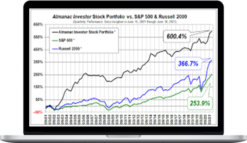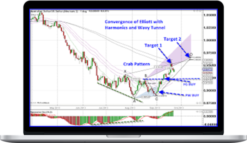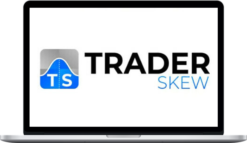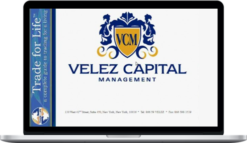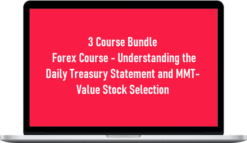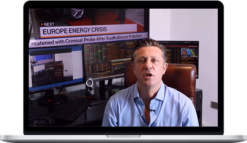Wyckoff SMI – Wyckoff Unleashed Official Beginners Online Course
$349.99 $193.00
Delivery: Within 7 days
Description
Wyckoff SMI – Wyckoff Unleashed Official Beginners Online Course
Mr. Richard D. Wyckoff started our Stock Market Institute in 1931 and we stay true to his original teachings. Wyckoff Unleashed is our official course teaching the Wyckoff Trading Method. This course was the first ever Wyckoff Stock Market Institute course to be offered online!
The Wyckoff Unleashed course guides students through not only the fundamentals of the Wyckoff Trading Method but also includes lessons how to implement the Wyckoff Trading Method while using Wyckoff SMI’s Proprietary Indicator Bundle that includes access to our world renowned Wyckoff Indicators the OP, Force & Technometer.
Without access to these indicators and the knowledge required on how to use them properly, it is impossible to gain even 50% of the benefit of the Wyckoff Trading Method. Through this course, you will have the chance to learn from the teachings of various Wyckoff instructors from this generation as well as past generations.
What You’ll Learn In Wyckoff Unleashed Official Beginners Online Course
The Basic Law Of Supply And Demand
The Basic Law of Supply and Demand governs all price changes. The best indicator of the future course of the stock market is the relation of supply to demand. Stated simply, a stock’s value begins to decline when the number of shares offered exceeds the number of bids for purchase.
Judging The Market By Its Own Action
No one can deny that in markets throughout the world, the big fish eat the little ones. Large operators could not operate successfully without the large number of people making up the public. The public is used so large operators can more easily do the trading they choose to do.
Charts
Many of the principal moves in the stock market are made by large operators (i.e., developers, well-informed insiders) whose work we must detect and follow. When important interests are accumulating a stock, a study of the transactions will frequently disclose the fact.
Buying and Selling Waves
Every upward or downward swing in the stock market, whether it amounts to many points, only a few points, or fractions of a point, consists of numerous buying and selling waves. These waves run just long enough to attract a following.
How A Campaign Is Conducted
After we have determined the position and probable trend of the general stock market and have examined the action of the various stocks to see which are most likely to follow or lead the market as a whole, we must single out those individual stocks that are in the best position
Market Technique and Volume Studies
Before moving on to further studies, we will summarize what we have learned in the previous sections. Supply and Demand. Always keep this in mind: prices move up and down in accordance with the Law of Supply and Demand.
Significance Of Trend Lines
To draw an analogy from physics, we could say that when a stock is being accumulated, it is storing up a force of demand which, when later released, provides the momentum for the ensuing upward movement.
Chart Studies – Vertical Charts
As we have seen from preceding lessons, the four principal phases of a market campaign are: 1) Accumulation 2) Marking Up 3) Distribution 4) Marking Down When a Stock is in phase 1 or 2 it is said to be in a bullish position.
Chart Studies – Figure Charts
The main subject of this lesson is figure charts, figure chart counts and the count guide. The lesson will have several objectives.
Buying and Selling Tests
Coordinating Your Studies In reading over the preceding sections, it may seem to you that the analysis of the market’s action and the behavior of individual stocks is quite complex, requiring a large expenditure of time and effort.
Refinements
In this section we discuss certain market phenomena which you are likely to encounter at various times. The first of these phenomena is the shake-out. There are two types of this phenomenon: (1) a terminal shake-out, and (2) an ordinary shake-out.
Stop Orders
The first rule in successful trading and investing is: Cut losses short. E. H. Harriman, who was once a broker on the floor of the New York Stock Exchange, said, “If you want to be a successful trader, kill your losses.” As a floor trader he used to close out a trade if it went l/2 to 1 point against him.
Accumulation
To begin, let us define accumulation. Accumulation refers to the process of establishing an investment or speculative position based on professional interests in anticipation of an advance in market price. This may be done in order to secure a large block of the stock before the market rises.
Jump Across The Creek
The purpose of this lesson will be to discuss with you the analogy of the jump across the creek story, where it fits into accumulation, how you can analyze it and use it to take a speculative position for potential profit with a minimum of risk.
Distribution and the Upthrust After Distribution
The main subject of this lecture will be distribution, it will also cover the principle of the upthrust after distribution.
The Wyckoff Wave Crypto Index and the Optimism-Pessimism Index
The main subject of Lesson 19 is the Wyckoff Wave Crypto Index and the Optimism-Pessimism Index. The purpose of this lesson is to discuss with you the origin, construction and the use of the Wyckoff Wave Crypto Index.
The Force
Because market action is measured in both price spread and volume, no single index average or indicator is enough for a trader to be able to interpret what is actually happening in the stock market. Each Wyckoff trading tool has a specific function.
The Technometer
The Wyckoff tools of Optimism-Pessimism, Force, and Technometer when combined with price and volume provide a variety of indications that are helpful in determining direction and timing. Some of these are easier to use than others.
General Instructions
CAUTIONARY SUGGESTIONS Your undertaking to learn this Method is evidence that you intend to reverse the rule of the public which is to monkey with the stock market buzz-saw before it knows what makes the wheels go round.
Philosophy
Cautionary Suggestions Continued The two elements vital to success in the markets are: (1) Knowledge of the principles taught in this Course and (2) Ability to apply these principles correctly.
Conclusion
In this course, Mr. Wyckoff and the Institution he founded have taken you into their confidence by giving you the best of all the ideas, plans, methods and technique that you need for common sense trading and investing.
Delivery Policy
When will I receive my course?
You will receive a link to download your course immediately or within 1 to 21 days. It depends on the product you buy, so please read the short description of the product carefully before making a purchase.
How is my course delivered?
We share courses through Google Drive, so once your order is complete, you'll receive an invitation to view the course in your email.
To avoid any delay in delivery, please provide a Google mail and enter your email address correctly in the Checkout Page.
In case you submit a wrong email address, please contact us to resend the course to the correct email.
How do I check status of my order?
Please log in to TradingAZ account then go to Order Page. You will find all your orders includes number, date, status and total price.
If the status is Processing: Your course is being uploaded. Please be patient and wait for us to complete your order. If your order has multiple courses and one of them has not been updated with the download link, the status of the order is also Processing.
If the status is Completed: Your course is ready for immediate download. Click "VIEW" to view details and download the course.
Where can I find my course?
Once your order is complete, a link to download the course will automatically be sent to your email.
You can also get the download link by logging into your TradingAZ account then going to Downloads Page.
Related products
Total sold: 11
Total sold: 17



